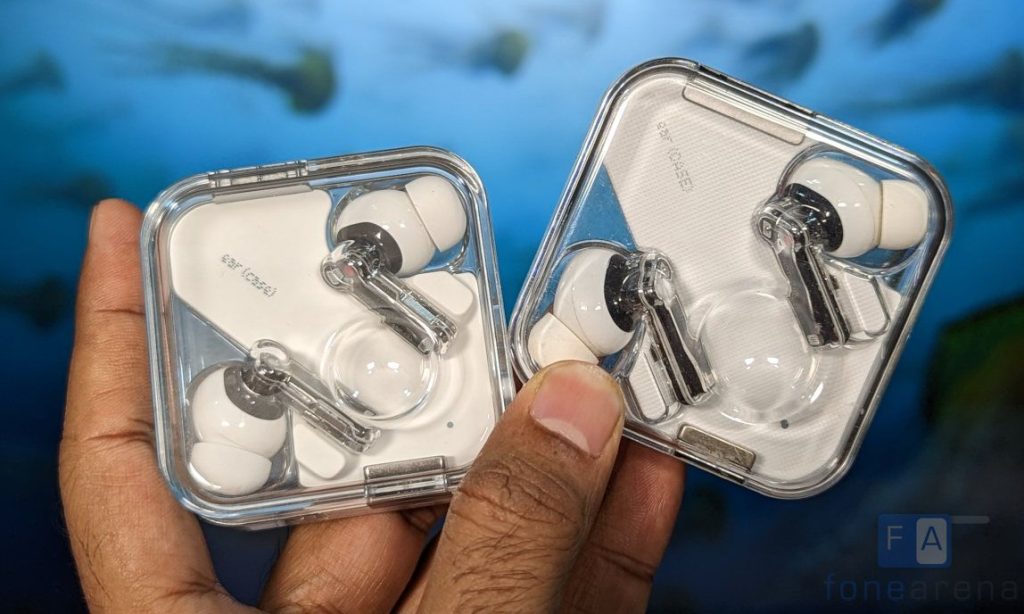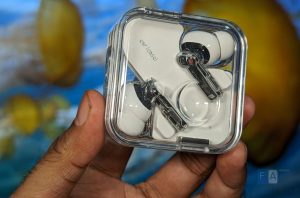
After the Ear (1) in 2021 and the Ear (Stick) last year, London-based consumer tech startup “Nothing” launched the ear (2), the company’s third earbuds today. The ear (2) carries over the eye-catching transparent design for the case and the earbuds, and adds Bluetooth 5.3 with LHDC 5.0 audio codec and also has better ANC as well as improvements to Clear Voice Technology. The case is also slightly smaller.
With all these, the price has also been increased. So, are these the best true wireless earbuds with ANC for the price? Let us dive into the review to find out.
Box Contents

- Nothing ear (2) in White colour
- Ear tips in Small and Large sizes (Medium pre-installed)
- Braided USB Type-C cable
- User guide
Design and Build Quality
Starting with the design, the headset comes in a familiar eye-catching transparent design, the same as the predecessor, developed by Stockholm-based teenage engineering. The centre part of the case has a white covering, while the other parts are transparent so that you can view the earbuds clearly. The case has magnets, so that it locks securely. There is also a magnet connecting the two parts of the case, and the earbuds also have a strong magnet that secures them in its place.
The base of the case has some specs for the case. The plastic white part is now on the top of the clear plastic, unlike the predecessor, so it doesn’t get scratched easily, but the top of the case still gets scatches if you carry the case with other items. There is a function key and a USB Type-C port on the side of the case.

The charging case measures 55.5×55.5×22mm and weighs 51.9 grams, making it slightly smaller than the predecessor. There is a tiny LED light on the case that glows in white, green and red colours. This time, the case also has IP55 ratings for dust and water resistance.

The in-ear earbuds still have a transparent design for the stem. The earbuds weigh about 4.5 grams, which is 0.2g lighter than the predecessor. These are also slightly smaller, measuring 29.4×21.5x 23.5mm. The microphone has moved from the back to the front, which offers better wind noise cancellation.
There is an optical sensor for wear detection so that it can automatically pause the audio when you remove it from your ears and play when you put it back.

You can also see the NOTHING ear (2) branding on the outside where the touch-sensitive area is present that lets you control play/pause, ANC and volume. The earphones have IP54 ratings for dust and water resistance, compared to IPX4 in the Ear (1). It can withstand splashes or light rain, but you can’t use it when swimming.

The fit was perfect, and it doesn’t come out easily, even during strenuous activities like running or workout. The Earbuds fit test option plays music to ensure that your ear tips make a good seal with your ear canal for better noise-cancelling. This is powered by Mimi.
Connectivity, Pairing, and Controls
The Nothing Ear (2) supports Bluetooth 5.3 with LHDC 5.0 Hi-Res audio codec for HD sound quality on supported devices, it also supports AAC codec that works in phones that have it. The LHDC 5.0 offers a transmission rate of up to 1Mbps for 4 times better detail, and transmitting frequencies up to 24 bit/192 kHz.
The pairing process is very easy for Nothing Phone (1). Just enable Bluetooth on the phone, open the charging case of the buds, place the charging case close to the phone, and follow the prompts. To connect to other devices, place the Buds into the charging case with the cover opened. Press and hold the setup button in the case for 2 seconds to enter Bluetooth settings. Then, select the Nothing Ear (2).
There is a fast pair option which works in latest Android phones. We tested it on the Pixel 7, Galaxy S23 and the Xiaomi 13 Pro, and never faced any pairing or disconnection issues. There is also Microsoft Swift Pair to connect it to Windows. Since the phone pairs with the case and not the headset, you will need the case if you want to reconnect it or even turn on the headset if it’s disconnected from the phone.
You can enable dual connection option that lets you connect to two devices at the same time and switch the audio playback between them. But the headset gets rebooted every time you need to disable or disable the feature.
The touch controls have been replaced with press controls to avoid any accidental touches and discomfort of tapping into the ear canal. This lets you skip tracks, switch between noise cancellation modes, and adjust volume – all with a press. The controls can be customised in the Nothing X app.
| Function | Left earphone (L) | Right earphone (R) |
| Play / Pause or Answer call / Hang calls | Single Pinch | |
| Skip forward / Decline Incoming call | Double Pinch | |
| Skip back | Triple Pinch | |
| Switch between ANC and Transparency Mode | Pinch and Hold | |
| Volume control | Customizable with Pinch and Hold / Double Pinch and Hold | |
Sliding to control volume is gone now, so you have to customize them with the Nothing X app on Android and iPhone. You can change actions for Triple Pinch, Pinch and Hold and Pinch and Hold for each bud, but you can’t customize single or double pinch.
You can disable in-ear Detection from the settings. There is ‘Find My Earbud’ option that makes high pitch sound so that you can locate the earbuds when you misplace them.
Audio Quality

The Nothing Ear (2) has a 11.6mm dynamic driver, but this time the company has used its in-house drivers and there is also a new dual-chamber design enhances the overall sound quality with smoother airflow.
LHDC worked with Nothing Phone (1), OnePlus 11 and Xiaomi 13 Pro, but not with other devices, including the Galaxy S23 and Pixel 7, which only showed AAC.
The audio quality is crisp with clear vocals, deeper low frequencies and the high frequencies were clear, thanks to the dual chamber design. However, the mid-range and the upper midrange are average compared to the high and low frequencies.
It features four equalizer presets – Balanced (default), More Bass, More Treble and Voice – so that every song can be heard how it should. You can also create custom EQ. The Personal Sound Profile with hearing ID lets you adjust the equaliser settings in real-time to match the user’s hearing for an optimal listening experience.
Noise Cancellation and Call Performance
Regarding the Noise cancellation, the Active Noise Cancellation (ANC) blocks the ambient sound up to 40dB, same as the Ear(1). Even though the depth is the same as the predecessor, the quality is way better. You can feel the difference when you are listening when outdoors and even indoors when the AC or fan is on.
There are four modes, Low, Mid, High and Adaptive Mode that automatically adjusts the noise reduction level based on your environment in real-time. There is also personalised ANC that calibrates ANC based on the exact shape of a user’s ear canal based on 7 audio filters. However, it is not perfect in varied sound conditions like switching from traffic or crowded areas. You can switch between noise cancellation, transparency and no noise cancellation with a pinch and hold on the earbuds.

This also has Transparency mode that allows you to listen to ambient sound so that you can recognize the surrounding situation and any potential risks. The low-latency gaming mode, which is called low lag mode, works automatically with the Nothing Phone (1), but you need to enable it from the settings for other devices. Without the low lag mode, the latency is too high, but it is decent with the mode enabled, but the company doesn’t reveal the value officially.
Coming to the call noise cancellation, it uses Clear Voice Technology for calls that uses three high-definition microphones to cut external noise. The company says that it uses advanced algorithms that analyse the input, referencing more than 20 million sound samples, more compared to the predecessor. It also has improved wind and crowd noise resistance. Based on my use, this feature has improved a lot, and the wind noise was completely cut out to the receiver, and the traffic noise were faintly audible.
Battery Life

The earphones pack 33mAh battery that promises about 6.3 hours of standalone battery life without ANC and 4 hours with ANC. During my use with LHDC and noise cancellation enabled, I got slightly over 3 hours in about 60% volume, which could have been better. With AAC and noise cancellation fully off, it lasted for close to 5.5 hours, which is decent. For calls, it lasts only for 3.5 hours since it uses call noise cancellation tech.
With the 485mAh charging case, smaller than the 570mAh in the predecessor, it promises up to 36 hours of total battery life without ANC and 22.5 hours of total battery life with noise cancellation enabled.
Even though the case and the battery are smaller, the total battery life is decent. The green light in the case indicates that the battery is full, and when it turns red, it is low. However, the light in the case doesn’t change even when the charge is low in the earbuds. You can also see the charge left in the case and the buds in the ear (1).

Charging the case fully with the earbuds takes about 1 and half hours. It also has fast charge, so that you get 8 hours (charging case + earbuds combined) of playback without ANC with 10 minutes of charging. The charging case also offers wireless charging, so you can simply drop your earbuds onto a Qi Wireless charging pad or on the back of a phone with reverse wireless charging.
Conclusion
Overall, Nothing ear (2) is a good active noise cancellation (ANC) TWS for the price. The design is very similar to the Ear(1) , but comes with a smaller case, offers better audio quality, ANC and call noise cancellation than the Ear(1) . The price has also increased to meet the cost and the team behind it. Wish the standalone battery life was better.
Priced at Rs. 9,999, which is Rs. 4000 more than the Ear(1), it will be available from Flipkart and Myntra online as well as select offline stores starting 28th March at 12 noon. There is a limited-period sale today, 25th March from 12 noon.
Alternatives
The OPPO Enco X2 at a slightly higher price offers better battery life and also has LDAC codec, and you could get a better deal during a sale. At the same price, the OnePlus Buds 2R is decent if you need spatial audio and better battery life, and don’t need wireless charging.
Pros
- Eye-catching design
- Bluetooth 5.3 with Dual connection
- Good audio quality
- Brilliant call quality
- Good ANC with customizable modes
- IP54 for buds and IP55 for case
Cons
- Battery life takes a hit if you use ANC + LHDC or make a lot of calls
- No LDAC and aptX codec
- Glossy case is prone to scratches
















